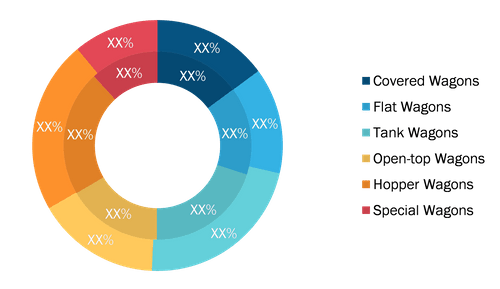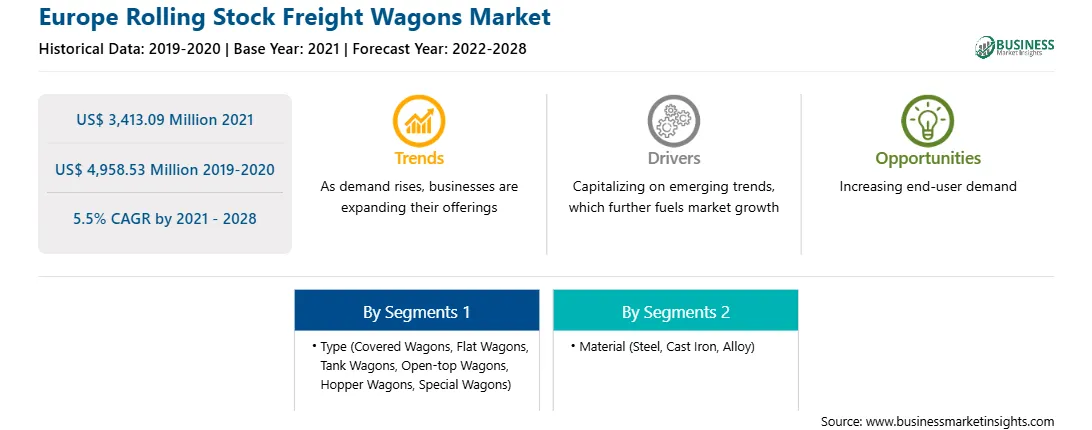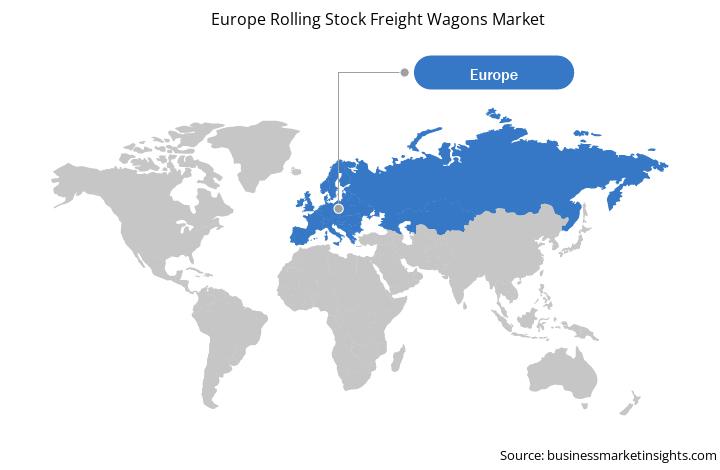The Europe rolling stock freight wagons market was valued at US$ 3,413.09 million in 2021 and is projected to reach US$ 4,958.53 million by 2028; it is expected to grow at a CAGR of 5.5% from 2021 to 2028.
The growth of the rolling stock freight wagons market is attributed to the rising adoption of rail freight transport by various industries. Rail freight transport is increasingly being seen as a viable and secure alternative to road freight transport, which is becoming increasingly costly and hampered by traffic jams. Rail is increasingly attracting shippers due to its performance, reliability, and new transportation concepts. One of the main benefits of rail freight is that only a few individuals are responsible for moving vast quantities of goods. For 40 to 60 trucks, only one locomotive driver is needed. With just a few individuals, large quantities of goods can be transported from point A to point B. Hence, shippers save a lot of money. The freight trains have ample freight capacity, and operating frequencies can be increased, if necessary. There are plenty of locomotives, staff, and wagons available. The terminal capacity is adequate. Additionally, RailGood's rail freight carriers, intermodal providers, and rail freight forwarders are ready to provide customers with appropriate transportation and logistics solutions. This is influencing the adoption of railways for the transportation of goods among several industries. For instance, Procter and Gamble (P&G) utilizes extensive railway services to distribute its products and procure raw material for its production across Europe. Thus, the high adoption of rail freight services by industries is influencing the growth the rolling stock freight wagon market across the region.
Impact of COVID-19 Pandemic on Rolling Stock Freight Wagons Market
In the first half of 2021, European railway networks seem to be facing financial difficulties. The year began ominously, with COVID-related losses for passenger and freight services, obliterating any hope for recovery in the months ahead. In comparison to passenger traffic, rail freight had a relatively minor effect. According to the Community of European Railway (CER), freight operators lost between 3% and 32% of their revenue in 2020. However, during the COVID-19 pandemic, rail freight transportation proved to be resilient. Though planes were grounded around the world and some container ships were refused entry to ports, trains continued to run almost nonstop from China to Europe, carrying essential supplies at times. According to rail freight organizers, in the first half of 2020, 5,122 trains ran on the Silk Road linking China and the West. Rail freight, which is normally limited by price and delivery times, has become more flexible during the pandemic after governments in the Netherlands and France reduced track access tariffs.
Additionally, owing to the negative impact on other rail freight routes, the European governments announced relief aid schemes for freight wagon transport operators. For instance, Germany's single-wagon rail freight transport companies will be eligible for up to EUR 600 million in government funding. The scheme was authorized by the European Commission under EU State aid law. The scheme, which will run until November 30, 2025, will allow for the "modal shift" of freight traffic from road to rail, lowering the cost of single-wagon rail freight transport.
The outbreak of the COVID-19 and the travel restrictions imposed across Europe impacted the manufacturing of freight wagons, owing to supply chain disruption. However, the growing reliability on rail freight transport between countries such as China and Europe created the demand for Freight wagons. The above-mentioned government schemes to aid the COVID-19 impacted sectors, including rail freight transport, are expected to enhance the market growth in the near future
Market Insights –
Rolling Stock Freight Wagons Market
Integration of Technology
The European government and the European Rail Freight Association (ERFA) are developing measures to upgrade and restructure railway infrastructure by providing improved traffic control, scheduling systems, and signaling. The significant growth of the Europe-Asia railway line, especially in China, is a major factor driving rail freight growth in Europe, resulting in increased trade between the two regions. According to ERFA, more than 500,000 tons of freight were transported by rail between China and Europe in 2016. 180,000 tons of cargo was shipped from China to Western Europe. Recent industry advances include the use of train-flow planning tools and big data analytics in rail freight operations to minimize redundant and premature train stopping and breaking, as well as transportation delays. In addition, the use of advanced GPS technology and the introduction of intelligent systems in goods wagons are expected to improve the productivity of the European rail freight transportation market.
Mobile applications, cloud computing, the Internet of Things (IoT), blockchain, and big data are being widely adopted across European rail freights, providing useful data for strategic decisions and more personalized services. They can also assist in achieving objectives such as energy savings, operational planning, and cost reduction. Thus, the integration of technology with rail freight wagons is expected to increase the efficiency of goods transportation, thereby providing growth opportunities to the European rolling stock freight wagons market over the forecast period.
Type-Based Insights
Based on type, the rolling stock freight wagons market is segmented into covered wagons, flat wagons, tank wagons, open-top wagons, hopper wagons, and special wagons. The hopper wagons segment held the largest market share in 2020.
Strategic insights for the Europe Rolling Stock Freight Wagons provides data-driven analysis of the industry landscape, including current trends, key players, and regional nuances. These insights offer actionable recommendations, enabling readers to differentiate themselves from competitors by identifying untapped segments or developing unique value propositions. Leveraging data analytics, these insights help industry players anticipate the market shifts, whether investors, manufacturers, or other stakeholders. A future-oriented perspective is essential, helping stakeholders anticipate market shifts and position themselves for long-term success in this dynamic region. Ultimately, effective strategic insights empower readers to make informed decisions that drive profitability and achieve their business objectives within the market. The geographic scope of the Europe Rolling Stock Freight Wagons refers to the specific areas in which a business operates and competes. Understanding local distinctions, such as diverse consumer preferences (e.g., demand for specific plug types or battery backup durations), varying economic conditions, and regulatory environments, is crucial for tailoring strategies to specific markets. Businesses can expand their reach by identifying underserved areas or adapting their offerings to meet local demands. A clear market focus allows for more effective resource allocation, targeted marketing campaigns, and better positioning against local competitors, ultimately driving growth in those targeted areas.
Europe Rolling Stock Freight Wagons Strategic Insights

Europe Rolling Stock Freight Wagons Report Scope
Report Attribute
Details
Market size in 2021
US$ 3,413.09 Million
Market Size by 2028
US$ 4,958.53 Million
CAGR (2021 - 2028) 5.5%
Historical Data
2019-2020
Forecast period
2022-2028
Segments Covered
By Type
By Material
Regions and Countries Covered
Europe
Market leaders and key company profiles
Europe Rolling Stock Freight Wagons Regional Insights

Material-Based Insights
Based on material, the rolling stock freight wagons market is segmented into steel, cast iron, and alloys. The alloys segment is projected to register the highest CAGR during the forecast period.
Strategic Insights
Players operating in the rolling stock freight wagons market are mainly focused on the development of advanced and efficient products.
The Europe rolling stock freight wagons market has been segmented as follows:
Europe Rolling Stock Freight Wagons Market – by
Type
Europe Rolling Stock Freight Wagons Market – by
Material
Europe Rolling Stock Freight Wagons Market – by
Country
Europe Rolling Stock Freight Wagons Market – Company Profiles
The List of Companies - Europe Rolling Stock Freight Wagons Market
The Europe Rolling Stock Freight Wagons Market is valued at US$ 3,413.09 Million in 2021, it is projected to reach US$ 4,958.53 Million by 2028.
As per our report Europe Rolling Stock Freight Wagons Market, the market size is valued at US$ 3,413.09 Million in 2021, projecting it to reach US$ 4,958.53 Million by 2028. This translates to a CAGR of approximately 5.5% during the forecast period.
The Europe Rolling Stock Freight Wagons Market report typically cover these key segments-
The historic period, base year, and forecast period can vary slightly depending on the specific market research report. However, for the Europe Rolling Stock Freight Wagons Market report:
The Europe Rolling Stock Freight Wagons Market is populated by several key players, each contributing to its growth and innovation. Some of the major players include:
The Europe Rolling Stock Freight Wagons Market report is valuable for diverse stakeholders, including:
Essentially, anyone involved in or considering involvement in the Europe Rolling Stock Freight Wagons Market value chain can benefit from the information contained in a comprehensive market report.